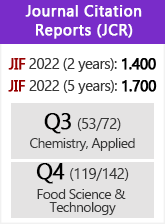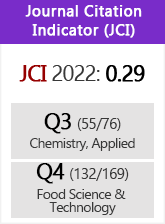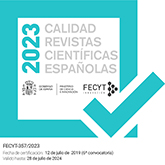Role of lactic acid bacteria in fermented vegetables
DOI:
https://doi.org/10.3989/gya.0344191Keywords:
Biofilms, LAB biodiversity, Multifunctional starters, VegetablesAbstract
The consumption of fermented vegetables is widespread throughout the world and represents an important component of the human diet with considerable contribution to the food supply for a world population in continuous growth. Many of the fermented vegetables share a general process which requires salting and acidification steps. Among the microorganisms responsible for fermentation, lactic acid bacteria are the most relevant with important organoleptic, quality and safety benefits. This review deals with the microbial ecology of fermented vegetables focusing on the biodiversity of lactic acid bacteria, the most important molecular techniques used for their identification and genotyping, their importance for the formation of biofilms as well as their use as starter cultures for obtaining high-quality and safe vegetable products.
Downloads
References
Abriouel H, Benomar N, Cobo A, Caballero N, Fernández-Fuentes MÁ, Pérez-Pulido R, Gálvez A. 2012. Characterization of lactic acid bacteria from naturally-fermented Manzanilla Aloreña green table olives. Food Microbiol. 32, 308-316. https://doi.org/10.1016/j.fm.2012.07.006 PMid:22986194
Abriouel H, Benomar N, Lucas R, Gálvez A. 2011. Culture-independent study of the diversity of microbial populations in brines during fermentation of naturally-fermented Aloreña green table olives. Int. J. Food Microbiol. 144, 487-496. https://doi.org/10.1016/j.ijfoodmicro.2010.11.006 PMid:21122933
Ampe F, ben Omar N, Moizan C, Wacher C, Guyot JP. 1999. Polyphasic study of the spatial distribution of microorganisms in Mexican pozol, a fermented maize dough, demonstrates the need for cultivation-independent methods to investigate traditional fermentations. Appl. Environ. Microbiol. 65, 5464-5473 https://doi.org/10.1128/AEM.65.12.5464-5473.1999 PMid:10584005 PMCid:PMC91745
Andersson RE, Daeschel MA, Eriksson CE. 1988. Controlled lactic acid fermentation of vegetables. In Proceedings: 8th International Biotechnology Symposium, Paris 1988/edited by G. Durand, L. Bobichon, J. Florent. [Paris, France]: Societe francaise de microbiologie, c1988.
Aponte M, Blaiotta G, Croce FL, Mazzaglia A, Farina, V, Settanni L, Moschetti G. 2012. Use of selected autochthonous lactic acid bacteria for Spanish-style table olive fermentation. Food Microbiol. 30, 8-16. https://doi.org/10.1016/j.fm.2011.10.005 PMid:22265277
Argyri AA, Zoumpopoulou G, Karatzas KA, Tsakalidou E, Nychas GJ, Panagou EZ, Tassou CC. 2013. Selection of potential probiotic lactic acid bacteria from fermented olives by in vitro tests. Food Microbiol. 33, 282-291. https://doi.org/10.1016/j.fm.2012.10.005 PMid:23200662
Arroyo-López FN, Querol A, Bautista-Gallego J, Garrido-Fernández A. 2008. Role of yeasts in table olive production. Int. J. Food Microbiol. 128, 189-196. https://doi.org/10.1016/j.ijfoodmicro.2008.08.018 PMid:18835502
Arroyo-López FN, Bautista-Gallego J, Domínguez-Manzano J, Romero-Gil V, Rodríguez-Gómez F, García-García P, Garrido-Fernández A, Jiménez-Díaz R. 2012a. Formation of lactic acid bacteria-yeasts communities on the olive surface during Spanish-style Manzanilla fermentations. Food Microbiol. 32, 295-301. https://doi.org/10.1016/j.fm.2012.07.003 PMid:22986192
Arroyo-López FN, Romero-Gil V, Bautista-Gallego J, Rodríguez-Gómez F, Jiménez-Díaz R, García-García P, Querol A, Garrido-Fernández A. 2012b. Yeasts in table olive processing: desirable or spoilage microorganisms? Int. J. Food Microbiol. 160, 42-49. https://doi.org/10.1016/j.ijfoodmicro.2012.08.003 PMid:23141644
Arroyo-López FN, Blanquet-Diot S, Denis S, Thévenot J, Chalancon S, Alric, M, Rodríguez-Gómez F, Romero-Gil V, Jiménez Díaz R, Garrido-Fernández A. 2014. Survival of pathogenic and lactobacilli species of fermented olives during simulated human digestion. Front. Microbiol. 5, 540. https://doi.org/10.3389/fmicb.2014.00540 PMid:25352842 PMCid:PMC4196563
Babuchowsk A, Laniewska-Moroz L, Warminska-Radyko I. 1999. Propionibacteria in fermented vegetables. Lait 79, 113-124. https://doi.org/10.1051/lait:199919
Bautista-Gallego J, Arroyo-López FN, Rantsiou K, Jiménez-Díaz R, Garrido-Fernández A, Cocolin LS. 2013. Screening of lactic acid bacteria isolated from fermented table olives with probiotic potential. Food Res. Int. 50, 135-142. https://doi.org/10.1016/j.foodres.2012.10.004
Bellis P de, Valerio F, Sisto A, Lonigro SL, Lavermicocca P. 2010. Probiotic table olives: microbial populations adhering on olive surface in fermentation sets inoculated with the probiotic strain Lactobacillus paracasei IMPC2.1 in an industrial plant. Int. J. Food Microbiol. 140, 6-13. https://doi.org/10.1016/j.ijfoodmicro.2010.02.024 PMid:20226556
Benítez-Cabello A, Bautista-Gallego J, Garrido-Fernández A, Rantsiou K, Cocolin L, Jiménez-Díaz R, Arroyo-López FN. 2016. RT-PCR-DGGE Analysis to Elucidate the Dominant Bacterial Species of Industrial Spanish-Style Green Table Olive Fermentations. Front Microbiol. 7, 1291. https://doi.org/10.3389/fmicb.2016.01291 PMid:27582739 PMCid:PMC4987347
Benítez-Cabello A, Calero-Delgado B, Rodríguez-Gómez F, Garrido-Fernández A, Jiménez-Díaz R, Arroyo-López FN. 2019. Biodiversity and multifunctional features of lactic acid bacteria isolated from table olive biofilms. Front. Microbiol. 10 (3), Art 836. https://doi.org/10.3389/fmicb.2019.00836 PMid:31057529 PMCid:PMC6479189
Botta C, Cocolin L. 2012. Microbial dynamics and biodiversity in table olive fermentation: culture-dependent and -independent approaches. Front Microbiol. 3, 245. https://doi.org/10.3389/fmicb.2012.00245 PMid:22783248 PMCid:PMC3390769
Botta C, Langerholc T, Cencič A, Cocolin L. 2014. In vitro selection and characterization of new probiotic candidates from table olive microbiota. Plos One. 9 (4). https://doi.org/10.1371/journal.pone.0094457 PMid:24714329 PMCid:PMC3979845
Breidt F, Medina E, Wafa D, Pérez-Díaz I, Franco W, Huang, HY, Johanningsmeier SD, Kim JH. 2013a. Characterization of cucumber fermentation spoilage bacteria by enrichment culture and 16S rDNA cloning. J. Food Sci. 78, M470-476. https://doi.org/10.1111/1750-3841.12057 PMid:23458751
Breidt F, McFeeters RF, Perez-Diaz I, Lee C. 2013b. Fermented vegetables. Ch. 33 in Doyle and Buchanan, Food Microbiology: Fundamentals and Frontiers, ASM Press. https://doi.org/10.1128/9781555818463.ch33
Cagno R di, Coda R, De Angelis M, Gobbetti M. 2013. Exploitation of vegetables and fruits through lactic acid fermentation. Food Microbiol. 33, 1-10. https://doi.org/10.1016/j.fm.2012.09.003 PMid:23122495
Castro A de, Rejano L, Sánchez AH, Montaño A. 1995. Fermentation of lye-treated carrots by Lactobacillus plantarum. J. Food Sci. 60, 316-319. https://doi.org/10.1111/j.1365-2621.1995.tb05663.x
Castro A de, Sánchez AH, López-López A, Cortés-Delgado A, Medina E, Montaño A. 2018. Microbiota and Metabolite Profiling of Spoiled Spanish-Style Green Table Olives. Metabolites 8, 73. https://doi.org/10.3390/metabo8040073 PMid:30384453 PMCid:PMC6316098
Cocolin L, Ercolini D. 2007. Molecular techniques in the microbial ecology of fermented foods, Springer Science & Business Media. https://doi.org/10.1007/978-0-387-74520-6
Corsetti A, Perpetuini G, Schirone M, Tofalo R, Suzzi G. 2012. Application of starter cultures to table olive fermentation: an overview on the experimental studies. Front Microbiol. 3. https://doi.org/10.3389/fmicb.2012.00248
Costilow RN, Gates K, Lacy ML. 1980. Molds in brined cucumbers: cause of softening during air-purging of fermentations. Appl. Environ. Microbiol. 40, 417-422. https://doi.org/10.1128/aem.40.2.417-422.1980 PMid:16345619 PMCid:PMC291590
Domínguez-Manzano J, Olmo-Ruiz C, Bautista-Gallego J, Arroyo-López FN, Garrido-Fernández, A, Jiménez-Díaz R. 2012. Biofilm formation on abiotic and biotic surfaces during Spanish style green table olive fermentation. Int. J. Food Microbiol. 157, 230-238. https://doi.org/10.1016/j.ijfoodmicro.2012.05.011 PMid:22656327
Elmacı SB, Tokatlı M, Dursun D, Özçelik F, Şanlıbaba P. 2015. Phenotypic and genotypic identification of lactic acid bacteria isolated from traditional pickles of the Çubuk region in Turkey. Folia Microbiol. 60, 241-251. https://doi.org/10.1007/s12223-014-0363-x PMid:25404550
Etchells JL, Bell TA. 1950. Classification of yeasts from the fermentation of commercially brined cucumbers. Farlowia 4, 87-112. https://doi.org/10.5962/p.315957
Etchells JL, Jones ID. 1943. Bacteriological changes in cucumber fermentation. Food Industries 15, 54-56.
Ferrocino I, Cocolin L. 2017. Current perspectives in food-based studies exploiting multi-omics approaches. Curr. Opin. Food Sci. 13, 10-15. https://doi.org/10.1016/j.cofs.2017.01.002
Fleming HP, Etchells JL, Thompson RL, Bell TA. 1975. Purging of Co2 from Cucumber Brines to Reduce Bloater Damage. J. Food.Sci. 40, 1304-1310. https://doi.org/10.1111/j.1365-2621.1975.tb01078.x
Franco W, Pérez-Díaz IM. 2013. Microbial interactions associated with secondary cucumber fermentation. J. Appl. Microbiol. 114, 161-172. https://doi.org/10.1111/jam.12022 PMid:23013318
Franco W, Pérez-Díaz IM, Johanningsmeier SD, McFeeters RF. 2012. Characteristics of Spoilage-Associated Secondary Cucumber Fermentation. Appl. Environ Microbiol. 78, 1273-1284. https://doi.org/10.1128/AEM.06605-11 PMid:22179234 PMCid:PMC3273025
Franzetti L, Scarpellini M, Vecchio A, Planeta D. 2011. Microbiological and safety evaluation of green table olives marketed in Italy. Ann. Microbiol. 61, 843-851. https://doi.org/10.1007/s13213-011-0205-x
Garrido-Fernández A, Adams MR, Fernández-Díez MJ. 1997. Table olives: production and processing, Springer Science & Business Media. https://doi.org/10.1007/978-1-4899-4683-6
Gebbers JO. 2007. Atherosclerosis, cholesterol, nutrition, and statins-a critical review. GMS Ger. Med. Sci. 5, 4.
Gililland JR, Vaughn RH. 1943. Characteristics of butyric acid bacteria from olives. J. Bacteriol. 46, 315. https://doi.org/10.1128/jb.46.4.315-322.1943 PMid:16560706 PMCid:PMC373823
González-Cancho F, Rejano-Navarro L, Rodríguez de la Borbolla, Alcalá JM. 1980. Formation of propionic acid during the conservation of table green olives, 3: Responsible microorganisms. Grasas Aceites 31, 245-250.
González-Ortiz G, Pérez JF, Gustavo-Hermes R, Molist F, Jiménez-Díaz R, Martín-Orue S. 2013. Screening the ability of natural feed ingredients to interfere with the adherence of enterotoxigenic Escherichia coli (ETEC) K88 to the porcine intestinal mucus. British J. Nutr. 111, 633-642. https://doi.org/10.1017/S0007114513003024 PMid:24047890
Granato D, Branco GF, Nazzaro F, Cruz AG, Faria JA. 2010. Functional foods and nondairy probiotic food development: trends, concepts, and products. Compr. Rev. Food Sci. Food Saf. 9 (3), 292-302. https://doi.org/10.1111/j.1541-4337.2010.00110.x PMid:33467814
Hernández A, Martín A, Aranda E, Pérez-Nevado F, Córdoba MG. 2007. Identification and characterization of yeast isolated from the elaboration of seasoned green table olives. Food Microbiol. 24, 346-351. https://doi.org/10.1016/j.fm.2006.07.022 PMid:17189760
Hong Y, Li J, Qin P, Lee SY, Kim HY. 2015. Predominant lactic acid bacteria in mukeunji, a long-term-aged kimchi, for different aging periods. Food Sci. Biotechnol. 24, 545-550. https://doi.org/10.1007/s10068-015-0071-6
Hurtado A, Reguant C, Bordons A, Rozès N. 2012. Lactic acid bacteria from fermented table olives. Food Microbiol. 31, 1-8. https://doi.org/10.1016/j.fm.2012.01.006 PMid:22475936
Jang S, Lee J, Jung U, Choi HS, Suh HJ. 2014. Identification of an anti-listerial domain from Pediococcus pentosaceus T1 derived from Kimchi, a traditional fermented vegetable. Food Control 43, 42-48. https://doi.org/10.1016/j.foodcont.2014.02.040
Ji K, Jang NY, Kim YT. 2015. Isolation of Lactic Acid Bacteria Showing Antioxidative and Probiotic Activities from Kimchi and Infant Feces. J. Microbiol. Biotechnol. 25, 1568-1577. https://doi.org/10.4014/jmb.1501.01077 PMid:25951843
Johanningsmeier S, McFeeters RF, Fleming HP, Thompson RL. 2007. Effects of Leuconostoc mesenteroides starter culture on fermentation of cabbage with reduced salt concentrations. J. Food Sci. 72, M166-172. https://doi.org/10.1111/j.1750-3841.2007.00372.x PMid:17995739
Johanningsmeier SD, McFeeters RF. 2013. Metabolism of lactic acid in fermented cucumbers by Lactobacillus buchneri and related species, potential spoilage organisms in reduced salt fermentations. Food Microbiol. 35, 129-135. https://doi.org/10.1016/j.fm.2013.03.004 PMid:23664264
Jung JY, Lee SH, Jin HM, Hahn Y, Madsen EL, Jeon CO. 2013. Metatranscriptomic analysis of lactic acid bacterial gene expression during kimchi fermentation. Int. J. Food Microbiol. 163, 171-179. https://doi.org/10.1016/j.ijfoodmicro.2013.02.022 PMid:23558201
Kawatomari T, Vaughn RH. 1956. Species of Clostridium associated with zapatera spoilages. J. Food Sci. 21, 481-490. https://doi.org/10.1111/j.1365-2621.1956.tb16946.x
Kim E, Cho Y, Lee Y, Han SK, Kim CG, Choo DW, Kim YR, Kim HY. 2017. A proteomic approach for rapid identification of Weissella species isolated from Korean fermented foods on MALDI-TOF MS supplemented with an in-house database. Int. J. Food Microbiol. 243, 9-15. https://doi.org/10.1016/j.ijfoodmicro.2016.11.027 PMid:27936381
Kyung KH, Medina E, Kim SG, Lee YJ, Kim KH, Choi JJ, Cho JH, Chung CH, Barrangou R, Breidt F. 2015. Microbial Ecology of Watery Kimchi. Food Control 80, M1031-8. https://doi.org/10.1111/1750-3841.12848 PMid:25847522
Lavermicocca P, Valerio F, Lonigro SL, Angelis MD, Morelli L, Callegari ML, Rizzello CG, Visconti A. 2005. Study of Adhesion and Survival of Lactobacilli and Bifidobacteria on Table Olives with the Aim of Formulating a New Probiotic Food. Appl. Environ. Microbiol. 71, 4233-4240. https://doi.org/10.1128/AEM.71.8.4233-4240.2005 PMid:16085808 PMCid:PMC1183302
Lee JS, Heo GY, Lee JW, Oh YJ, Park JA Park YH, Pyun YR, Ahn JS. 2005. Analysis of kimchi microflora using denaturing gradient gel electrophoresis. Int. J. Food Microbiol. 102, 143-150. https://doi.org/10.1016/j.ijfoodmicro.2004.12.010 PMid:15992614
Lee ME, Jang JY, Lee JH, Park HW, Choi HJ, Kim TW. 2015. Starter cultures for kimchi fermentation. J. Microbiol. Biotechnol. 25, 559-568. https://doi.org/10.4014/jmb.1501.01019 PMid:25674806
León-Romero Á, Domínguez-Manzano J, Garrido-Fernández A, Arroyo-López FN, Jiménez-Díaz R. 2016. Formation of in vitro mixed-species biofilms by Lactobacillus pentosus and yeasts isolated from Spanish-style green table olive Fermentations. Appl. Environ. Microbiol. 82, 689-695. https://doi.org/10.1128/AEM.02727-15 PMid:26567305 PMCid:PMC4711112
Lucena-Padrós H, Caballero-Guerrero B, Maldonado-Barragán A, Ruiz Barba JL. 2014. Microbial diversity and dynamics of Spanish-style green table-olive fermentations in large manufacturing companies through culture-dependent Techniques. Food Microbiol. 42, 154-165. https://doi.org/10.1016/j.fm.2014.03.020 PMid:24929732
Lucena-Padrós H, Jiménez E, Maldonado-Barragán M, Rodriguez JM, Ruiz-Barba JL. 2015. PCR-DGGE assessment of the bacterial diversity in Spanish-style green table olive fermentations. Int. J. Food Microbiol. 205, 47-53. https://doi.org/10.1016/j.ijfoodmicro.2015.03.033 PMid:25886017
Luke FK. 1996. Lactic acid bacteria involved in food fermentations and their present and future uses in food industry. Lactic Acid Bacteria: Current Advances in Metabolism, Genetics and Applications. Vol. H98. Ed. Faruk Bozoglu and Bibek Ray. Springer-Verlag Berlin Heidelberg.
Mattos FR, Fasina OO, Reina LD, Fleming HP, Breidt F, Damasceno GS, Passos FV. 2005. Heat Transfer and Microbial Kinetics Modeling to Determine the Location of Microorganisms within Cucumber Fruit. J. Food Sci. 70, E324-E330. https://doi.org/10.1111/j.1365-2621.2005.tb09972.x
Medina E, Arroyo-López FN. 2015. Presence of toxic microbial metabolites in table olives. Front. Microbiol. 6. https://doi.org/10.3389/fmicb.2015.00873 PMid:26379648 PMCid:PMC4552003
Medina E, Pérez Díaz IM, Breidt F, Hayes J, Franco W, Butz N, Azcarate Peril MA. 2016. Bacterial Ecology of Fermented Cucumber Rising pH Spoilage as Determined by Nonculture-Based Methods. J. Food Sci. 81, M121-M129. https://doi.org/10.1111/1750-3841.13158 PMid:26605993 PMCid:PMC4973622
Medina E, Ruiz-Bellido MA, Romero-Gil V, Rodríguez-Gómez F, Montes-Borrego M, Landa BB, Arroyo-López FN. 2016. Assessment of the bacterial community in directly brined Aloreña de Málaga table olive fermentations by metagenetic analysis. Int. J. Food Microbiol. 236, 47-55. https://doi.org/10.1016/j.ijfoodmicro.2016.07.014 PMid:27442850
Medina E, Brenes M, García P, Romero C. 2018. Microbial ecology along the processing of Spanish olives darkened by oxidation. Food Control 86, 35-41. https://doi.org/10.1016/j.foodcont.2017.10.035
Montet D, Ray RC, Zakhia-Rozis N. 2014. Lactic Acid Fermentation of Vegetables and Fruits. Microorganisms and Fermentation of Traditional Foods Chapter 4, 108-140.
Moon SH, Chang M, Kim HY, Chang HC. 2014. Pichia kudriavzevii is the major yeast involved in film-formation, off-odor production, and texture-softening in over-ripened Kimchi. Food Sci. Biotechnol. 23, 489-497. https://doi.org/10.1007/s10068-014-0067-7
Pederson CS, Albury MN. 1969. The sauerkraut fermentation, bulletin 824. Geneva, NY: New York State Agricultural Experiment Station.
Peres CM, Peres C, Hernández-Mendoza A, Malcata FX. 2012. Review on fermented plant materials as carriers and sources of potentially probiotic lactic acid bacteria - With an emphasis on table olives. Trends Food Sci. Technol. 26, 31-42. https://doi.org/10.1016/j.tifs.2012.01.006
Peréz-Díaz IM, Breidt F, Buescher RW, Arroyo-López FN, Jiménez Dıaz R, Garrido-Fernández, A, Bautista-Gallego J, Yoon SS, Johanningsmeire, SD. (2013). Fermented and acidified vegetables. Compendium of methods for the microbiological examination of foods, 4th edn. American Public Health Association, Washington, DC, 521-532. https://doi.org/10.2105/MBEF.0222.056
Plastourgos S, Vaughn RH. 1957. Species of Propionibacterium associated with zapatera spoilage of olives. Applied Microbiology 5 (4), 267. https://doi.org/10.1128/AEM.5.4.267-271.1957 PMid:13459317 PMCid:PMC1057302
Plengvidhya V, Breidt F, Lu Z, Fleming HP. 2007. DNA Fingerprinting of Lactic Acid Bacteria in Sauerkraut Fermentations. Appl. Environ. Microbiol. 73, 7697-7702. https://doi.org/10.1128/AEM.01342-07 PMid:17921264 PMCid:PMC2168044
Rabie MA, Siliha H, el-Saidy S, el-Badawy AA, Malcata FX. 2011. Reduced biogenic amine contents in sauerkraut via addition of selected lactic acid bacteria. Food Chem. 129, 1778-1782. https://doi.org/10.1016/j.foodchem.2011.05.106
Randazzo CL, Restuccia C, Romano AD, Caggia C. 2004. Lactobacillus casei, dominant species in naturally fermented Sicilian green olives. Int. J. Food Microbiol. 90, 9-14. https://doi.org/10.1016/S0168-1605(03)00159-4
Rejano L, Sánchez AH, de Castro A, Montaño A. 1997. Chemical characteristics and storage stability of pickled garlic prepared using different processes. J. Food Sci. 62, 1120-1123. https://doi.org/10.1111/j.1365-2621.1997.tb12226.x
Reina LD, Pérez-Díaz IM, Breidt F, Azcarate-Peril MA, Medina E, Butz N. 2015. Characterization of the microbial diversity in yacon spontaneous fermentation at 20 °C. Int. J. Food Microbiol. 203, 35-40. https://doi.org/10.1016/j.ijfoodmicro.2015.03.007 PMid:25777679 PMCid:PMC4587664
Rodríguez-Gómez F, Arroyo-López FN, López-López A, Bautista-Gallego J, Garrido-Fernández A. 2010. Lipolytic activity of the yeast species associated with the fermentation/storage phase of ripe olive processing. Food Microbiol. 27, 604-612. https://doi.org/10.1016/j.fm.2010.02.003 PMid:20510778
Rodríguez-Gómez F, Romero-Gil V, García-García P, Garrido-Fernández A, Arroyo-López FN. 2014. Fortification of table olive packing with the potential probiotic bacteria Lactobacillus pentosus TOMC-LAB2. Front. Microbiol. 5. https://doi.org/10.3389/fmicb.2014.00467 PMid:25232354 PMCid:PMC4153319
Romero-Gil V, Rodríguez-Gómez F, Garrido-Fernández A, García-García P, Arroyo-López FN. 2016. Lactobacillus pentosus is the dominant species in spoilt packaged Aloreña de Málaga table olives. LWT-Food Sci. Technol. 70, 252-260. https://doi.org/10.1016/j.lwt.2016.02.058
Ruiz-Barba JL, Brenes-Balbuena M, Jiménez-Díaz R, García-García P, Garrido-Fernández A. 1993. Inhibition of Lactobacillus plantarum by polyphenols extracted from two different kinds of olive brine. J. Appl. Bacteriol. 74 (1), 15-19. https://doi.org/10.1111/j.1365-2672.1993.tb02990.x
Samish Z, Etinger-Tulczynska R, Bick M. 1963. The Microflora Within the Tissue of Fruits and Vegetables. J. Food Sci. 28, 259-266. https://doi.org/10.1111/j.1365-2621.1963.tb00194.x
Sánchez AH, de Castro A, Rejano L. 1992. Controlled fermentation of caperberries. J. Food Sci. 57, 675-678. https://doi.org/10.1111/j.1365-2621.1992.tb08069.x
Tamminen M, Joutsjoki T, Sjöblom M, Joutsen M, Palva A, Ryhänen EL, Joutsjoki V. 2004. Screening of lactic acid bacteria from fermented vegetables by carbohydrate profiling and PCR-ELISA. Lett. Appl. Microbiol. 39, 439-444. https://doi.org/10.1111/j.1472-765X.2004.01607.x PMid:15482435
Tofalo R, Perpetuini G, Schirone M, Ciarrocchi A, Fasoli G, Suzzi G, Corsetti A. 2014. Lactobacillus pentosus dominates spontaneous fermentation of Italian table olives. LWT - Food Sci. Technol. 57, 710-717. https://doi.org/10.1016/j.lwt.2014.01.035
Vaughn RH, Stevenson KE, Davé BA, Park HC. 1972. Fermenting yeasts associated with softening and gas-pocket formation in olives. Appl. Microbiol. 23 (2), 316-320. https://doi.org/10.1128/am.23.2.316-320.1972 PMid:5017677 PMCid:PMC380338
Yan P, Chai Z, Chang X, Zhao W, Yue H, Zhang T. 2015. Screening and identification of microorganism degrading nitrite in Chinese sauerkraut. Agro Food Ind. HiTech. 26, 20-23.
Yu J, Gao W, Qing M, Sun Z, Wang W, Liu W, Pan L, Sun T, Wang H, Bai N, Zhang H. 2012. Identification and characterization of lactic acid bacteria isolated from traditional pickles in Sichuan, China. J. Gen. Appl. Microbiol. 58 (3), 163-172. https://doi.org/10.2323/jgam.58.163 PMid:22878734
Yue, XQ, Li X, Wu JR, Zhang M. 2013. Isolation and Identification of Lactobacillus from Naturally Fermented Sauerkraut Juices in Xifeng. Adv. Mater. Res Res. 726-731, 147-150. https://doi.org/10.4028/www.scientific.net/AMR.726-731.147
Published
How to Cite
Issue
Section
License
Copyright (c) 2020 Consejo Superior de Investigaciones Científicas (CSIC)

This work is licensed under a Creative Commons Attribution 4.0 International License.
© CSIC. Manuscripts published in both the printed and online versions of this Journal are the property of Consejo Superior de Investigaciones Científicas, and quoting this source is a requirement for any partial or full reproduction.All contents of this electronic edition, except where otherwise noted, are distributed under a “Creative Commons Attribution 4.0 International” (CC BY 4.0) License. You may read here the basic information and the legal text of the license. The indication of the CC BY 4.0 License must be expressly stated in this way when necessary.
Self-archiving in repositories, personal webpages or similar, of any version other than the published by the Editor, is not allowed.
















